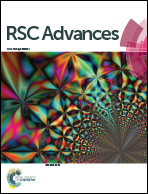Study on the interaction behavior of lysozyme with lanthanide ions by flow injection chemiluminescence analysis
Abstract
The interaction behavior of lysozyme with trivalent lanthanide ions (LnIII) was investigated by flow injection chemiluminescence (FI-CL) analysis. It was found that lysozyme with LnIII could form a 1 : 1 association complex that remarkably quenched CL intensity from the luminol–lysozyme reaction, and the quantitative correlation equation of CL intensity decrements versus the logarithm of the concentration of LnIII ΔI = A ln CLn + B was established. The results showed the sensitive factor A varied as atomic number Z increased monotonically, and ALL of light lanthanides (LL) from LaIII to EuIII was less than AHL of heavy lanthanides (HL) from GdIII to LuIII. The relationships of A vs. Z plot for LL and HL with a GdIII break at f7 were clearly presented, and the correlations of A with physical parameters (γ±, ΔHhyd and Eo) of LnIII were discussed. Using a homemade FI-CL model, the binding constants (K = 105 to 106 level) and binding sites (n = 1.0) were obtained, and the binding affinity abilities increased with increasing Z along the LnIII series. The thermodynamic parameters of lysozyme with LnIII were obtained, and the results showed that the reaction was a spontaneous process by electrostatic interaction. The possible mechanism and application of the luminol–lysozyme–LnIII CL system were given.


 Please wait while we load your content...
Please wait while we load your content...